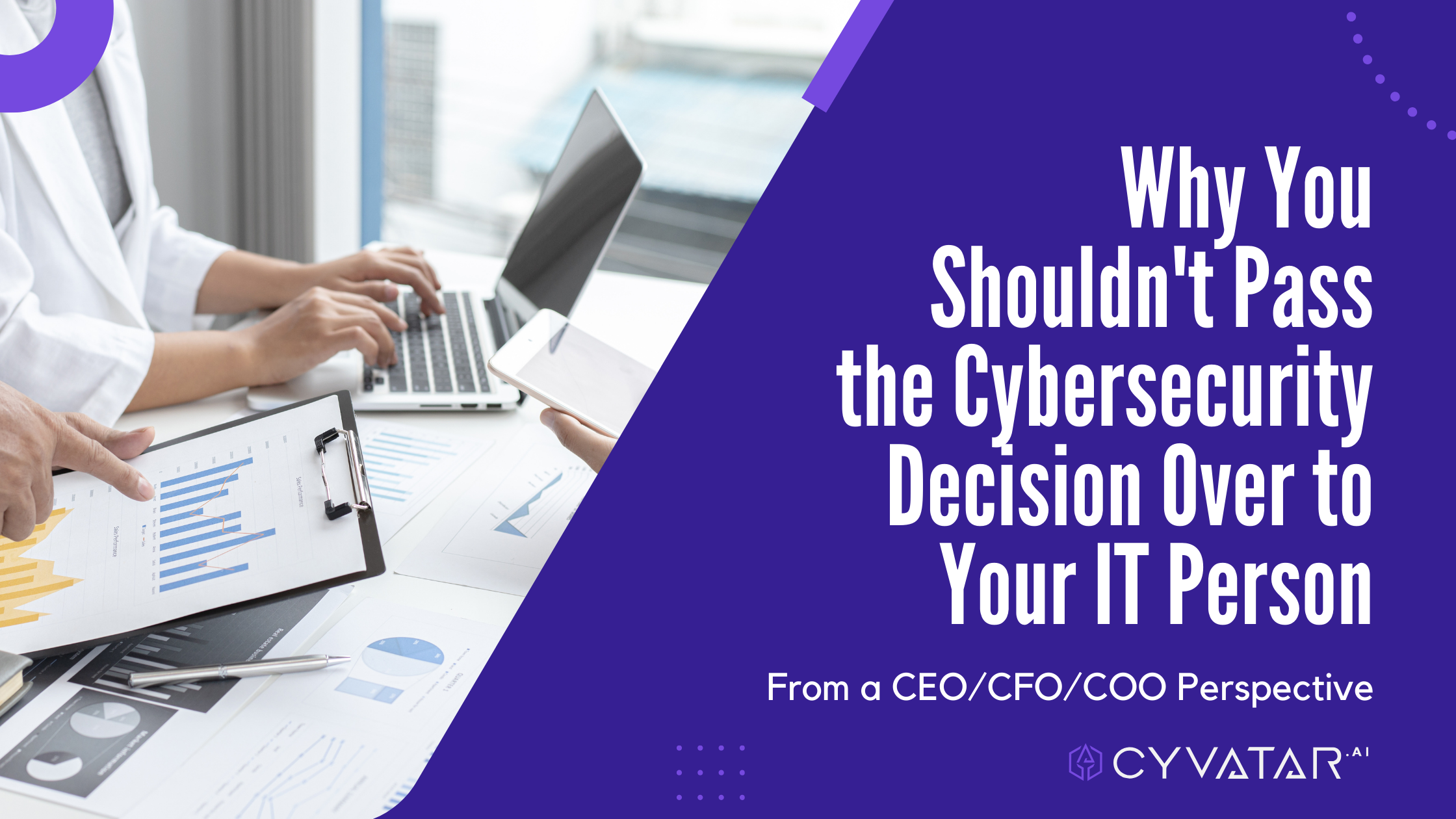Why You Shouldn’t Pass the Cybersecurity Decision Over to Your IT Person: From a CEO/CFO/COO Perspective

Why You Shouldn’t Pass the Cybersecurity Decision Over to Your IT Person: From a CEO/CFO/COO Perspective
Courtney Pereira | 08/12/2024Introduction
Imagine you’re the captain of a ship navigating through treacherous waters. Would you delegate the responsibility of steering to just any crew member? Probably not. Cybersecurity in today’s business landscape is no different. It’s a critical aspect of any business, and its importance cannot be overstated. Often, SMBs tend to delegate cybersecurity decisions solely to their IT personnel. However, from a CEO, CFO, or COO perspective, it’s essential to understand why cybersecurity should be a strategic business decision and not just a technical one.
The Bigger Picture: Business Objectives
As a CEO, CFO, or COO, your primary focus is on the overall business objectives, growth, and sustainability of the company. Cybersecurity is intrinsically linked to these objectives. A single breach can have devastating financial and reputational consequences, potentially derailing your business goals. Think of cybersecurity as the sturdy hull of your ship – without it, you’re vulnerable to sinking no matter how skilled your crew is.
Risk Management
Cybersecurity is a vital component of risk management. While IT personnel have the technical expertise, understanding the broader risk implications requires a strategic perspective. Executives are better positioned to assess the potential impact of cybersecurity risks on business operations, finances, and reputation. It’s like having a navigator who understands not just the immediate hazards but the long-term journey and destination.
Financial Implications
Cybersecurity investments can be significant. As a CFO, you need to balance the costs of implementing robust cybersecurity measures with the potential financial losses from a breach. This involves making informed decisions about budget allocations, ROI on cybersecurity investments, and cost-benefit analyses, which go beyond the scope of an IT department. It’s akin to managing the ship’s resources – you need to ensure that you’re well-stocked and prepared for any eventuality without overspending.
Compliance and Regulatory Requirements
Staying compliant with industry standards and regulatory requirements is crucial. Non-compliance can result in hefty fines and legal issues. As an executive, you need to ensure that your cybersecurity strategy aligns with these requirements, which often involves legal and operational considerations beyond the technical aspects handled by IT. Think of this as ensuring your ship is seaworthy and meets all maritime laws, avoiding any penalties that could arise from negligence.
Strategic Decision-Making
Cybersecurity decisions should be aligned with the company’s strategic goals. This includes integrating cybersecurity into business processes, product development, and customer interactions. Executives are responsible for ensuring that cybersecurity supports and enhances business strategies rather than being a standalone IT issue. It’s about plotting a course that ensures smooth sailing and reaching your desired destination efficiently.
Collaborative Approach
While IT personnel play a crucial role in implementing cybersecurity measures, the overall strategy should involve collaboration between IT, finance, legal, and executive leadership. This ensures that cybersecurity is integrated into the company’s broader risk management and strategic planning processes. Think of this as a coordinated effort where every crew member knows their role and works together to keep the ship on course.
Case Study: Target Data Breach
In 2013, Target suffered a massive data breach that exposed the credit card information of over 40 million customers. The breach resulted in significant financial loss, a damaged reputation, and the resignation of key executives. The lack of executive involvement in cybersecurity decision-making was a critical factor in the breach. This incident underscores the importance of having executive oversight and a strategic approach to cybersecurity.
Case Study: Equifax Data Breach
The 2017 Equifax breach exposed sensitive personal information of approximately 147 million people. The company faced severe repercussions, including hefty fines and a significant loss of consumer trust. This breach highlighted the need for executive leaders to prioritize cybersecurity and incorporate it into their overall business strategy. Equifax’s failure to do so had devastating consequences.
How Cyvatar Can Help
Cyvatar bridges the gap between IT and executive leadership, offering a holistic approach to cybersecurity. Our services include comprehensive risk assessments, strategic planning, and continuous monitoring, ensuring that cybersecurity decisions align with business objectives. With Cyvatar, executives can make informed decisions backed by expert insights and advanced security tools. Our managed services ensure that your cybersecurity strategy is not only robust but also integrated seamlessly into your overall business plan.
Conclusion
Cybersecurity is more than just an IT issue; it’s a critical business function that requires executive oversight and strategic decision-making. By taking an active role in cybersecurity, CEOs, CFOs, and COOs can ensure that their company is not only protected but also positioned for long-term success. Collaboration between IT and executive leadership is key to building a resilient and secure organization. Just as a ship requires both a skilled crew and a wise captain, your business needs both technical expertise and strategic oversight to navigate the complex waters of cybersecurity.
